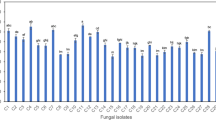Abstract
1,2-Benzenedicarboxaldehyde-3,4,5-trihydroxy-6-methyl (flavipin) was found to be antagonistic against nematodes and fungi. Here we demonstrated that flavipin is a potent antioxidant in vitro and in vivo, which has great potential in the therapy for free radical-associated diseases. Therefore, flavipin-producing bio-source was screened from 80 endophytes in Ginkgo biloba. Seven endophytic fungi were able to synthesize antioxidant substances and identified by ITS rDNA sequences. Among them, Chaetomium globosum CDW7 was a remarkable producer of flavipin. The fermentation parameters of CDW7 were then optimized for high flavipin production. Cultured under the optimal condition (25 °C, 100/250 mL flask, 12 discs/flask, 150 rpm, pH 6.5) for 14 days, CDW7 was able to synthesize flavipin at a production of 315.5 mg/L. In addition, flavipin output was positively correlated to antioxidant activities of crude extracts with a correlation coefficient of 0.8235, indicating that flavipin was the major antioxidant component of CDW7's metabolites. These data demonstrated that CDW7 was a highly yielded bio-source of antioxidant flavipin.




Similar content being viewed by others
References
Benzie IFF, Strain JJ (1996) The ferric reducing ability of plasma (FRAP) as a measure of “antioxidant power” The FRAP assay. Anal Biochem 239:70–76
Bamford PC, Norris GLF, Ward G (1961) Flavipin production by Epicoccum species. Trans Brit Mycol Soc 44:354–356
Bashyal BP, Wijeratne EMK, Faeth SH, Gunatilaka AAL (2005) Globosumones A-C, cytotoxic orsellinic acid esters from the Sonoran desert endophytic fungus Chaetomium globosum. J Nat Prod 68(5):724–728
Bradford MM (1976) A rapid and sensitive method for the quantitation of microgram quantities of protein utilizing the principle of protein-dye binding. Anal Chem 72:248–254
Chen Y, Mao WJ, Tao HW, Zhu WM, Qi XH, Chen YL, Li HY, Zhao CQ, Yang YP, Hou YJ, Wang CY, Li N (2011) Structural characterization and antioxidant properties of an exopolysaccharide produced by the mangrove endophytic fungus Aspergillus sp. Y16. Biores Technol 102:8179–8184
Dávalos C, Gómez-Cordovés C, Bartolomé B (2004) Extending applicability of oxygen radical absorbance capacity (ORAC-fluorescein) assay. J Agr Food Chem 52:48–54
Ding G, Song YC, Chen JR, Xu C, Ge HM, Wang XT, Tan RX (2006) Chaetoglobosin U, a cytochalasan alkaloid from endophyfle Chaetomium globosum IFB-E019. J Nat Prod 69(2):302–304
Finkel T, Holbrook NJ (2000) Oxidants, oxidative stress and the biology of aging. Nature 408:239–247
Gao LW, Wang JW (2012) Antioxidant potential and DNA damage protection activity of aqueous extract from Amillaria mellea. J Food Biochem 36:139–148
Huang WY, Cai YZ, Xing J, Corke H, Sun M (2007) A potential antioxidant resource: endophytic fungi from medicinal plants. Econ Bot 61:14–30
James K, Susan LF, James E, Walter F, David J (2002) Isolation of flavipin, a fungus compound antagonistic to plant-parasitic nematodes. Nematology 4:55–63
Liu J, Luo JG, Ye H (2010) In vitro and in vivo antioxidant activity of exopolysaccharides from endophytic bacterium Paenibacillus polymyxa EJS-3. Carbohyd Polym 82:1278–1283
Liu JY, Song YC, Zhang Z, Wang L, Guo ZJ, Zou WX, Tan RX (2004) Aspergillus fumigatus CY018, an endophytic fungus in Cynodon dactylon as a versatile producer of new and bioactive metabolites. J Biotechnol 114:279–287
Madrigal C, Tadeo JL, Melgarejo P (1991) Relationship between flavipin production by Epicoccum nigrum and antagonism against Monilinia laxa. Mycol Res 95:1375–1381
Mapari SAS, Nielsen KF, Larsen TO, Frisvad JC, Meyer AS, Thrane U (2005) Exploring fungal biodiversity for the production of water-soluble pigments as potential natural food colorants. Curr Opin Biotech 16(2):231–238
Phongpaichit S, Rungjindamai N, Rukachaisirikul V, Sakayaroj J (2006) Antimicrobial activity in cultures of endophytic fungi isolated from Garcinia species. FEMS Immunol Med Microbiol 48:367–372
Qin JC, Zhang YM, Gao JM, Bai MS, Yang SX, Laatsch H, Zhang AL (2009) Bioactive metabolites produced by Chaetomium globosum, an endophytic fungus isolated from Ginkgo biloba. Boorgan Med Chem 19(6):1572–1574
Raistrick H, Rudman P (1956) Studies in the biochemistry of micro-organisms. 97. Flavipin, a crystalline metabolite of Aspergillus flavipes (Bainier and Sartory) Thom and Church and Aspergillus terreus Thom. Biochem J 63:395–406
Re R, Pellegrini N, Proteggente A, Pannala A, Yang M, Rice-Evans C (1999) Antioxidant activity applying an improved ABTS radical cation decolorization assay. Free Radical Bio Med 26:1231–1237
Skrede G, Larsen VB, Aaby K, Jorgensen AS, Birkeland SE (2004) Antioxidative properties of commercial fruit preparations and stability of bilberry and black currant extracts in milk products. J Food Sci 69:351–356
Sekita S, Yoshihira K, Natori S, Udagawa SI, Sakabe F, Kurata H, Umeda M (1982) Chaetoglobosins, cytotoxic 10-(indol-3-yl)-[13]cytochalasans from Chaetomium spp. I. Production, isolation and some cytological effects of chaetoglobosins A-J. Chem Pharm Bull 30:1609–1617
White GA, Elliott WB (1980) Inhibition of electron transport and oxidative phosphorylation in plant mitochondria by gladiolic acid and structurally-related aromatic ortho daildehydes. Can J Biotechnol 58:9–22
Wand S, Li XM, Teuscher F, Li DL, Diesel A, Ebel R, Proksch P, Wang BG (2006) Chaetopyranin, a benzaldehyde derivative, and other related metabolites from Chaetomium globosum, an endophytic fungus derived from the marine red alga Polysiphonia urceolata. J Nat Prod 69(11):1622–1625
Acknowledgments
This work was co-supported by the National Basic Research Program of China (2010CB126104), National Natural Science Foundation of China (30901854), Fundamental Research Funds for the Central Universities (KYZ201107), Special Fund for Agro-scientific Research in the Public Interest (201303023), and Open Research Fund Program of Jiangsu Key Laboratory of Pesticide Science (NYXKT201202).
Author information
Authors and Affiliations
Corresponding authors
Additional information
Yonghao Ye and Yu Xiao contributed equally to this paper.
Electronic supplementary material
Below is the link to the electronic supplementary material.
ESM 1
(PDF 90 kb)
Rights and permissions
About this article
Cite this article
Ye, Y., Xiao, Y., Ma, L. et al. Flavipin in Chaetomium globosum CDW7, an endophytic fungus from Ginkgo biloba, contributes to antioxidant activity. Appl Microbiol Biotechnol 97, 7131–7139 (2013). https://doi.org/10.1007/s00253-013-5013-8
Received:
Revised:
Accepted:
Published:
Issue Date:
DOI: https://doi.org/10.1007/s00253-013-5013-8




